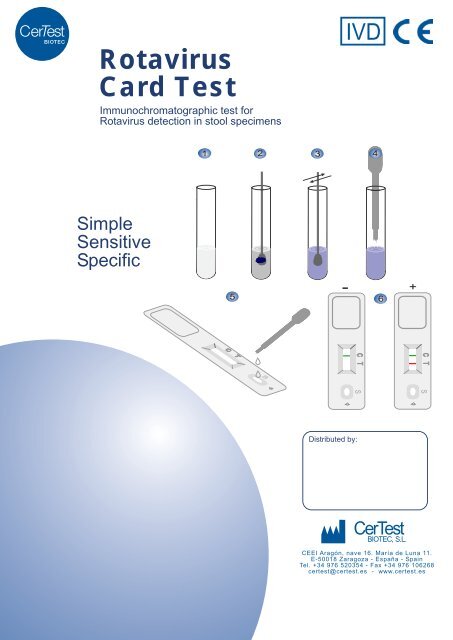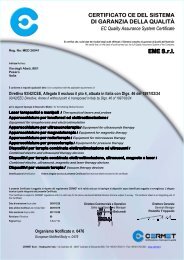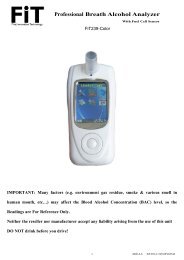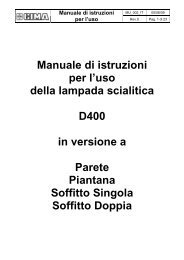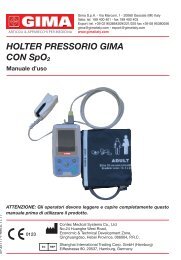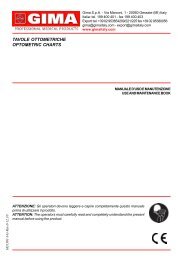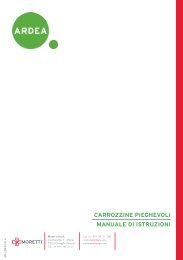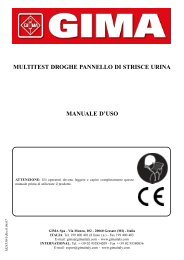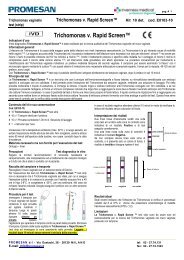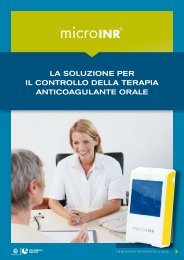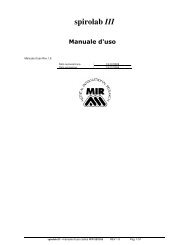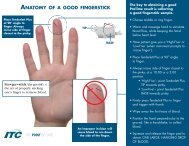You also want an ePaper? Increase the reach of your titles
YUMPU automatically turns print PDFs into web optimized ePapers that Google loves.
<strong>Rotavirus</strong><br />
<strong>Card</strong> <strong>Test</strong><br />
Immunochromatographic test for<br />
<strong>Rotavirus</strong> detection in stool specimens<br />
IVD<br />
1 2 3 4<br />
Simple<br />
Sens<strong>it</strong>ive<br />
Specific<br />
5<br />
-<br />
6<br />
+<br />
C<br />
T S<br />
C<br />
T S<br />
C<br />
T S<br />
Distributed by:<br />
Cer<strong>Test</strong><br />
BIOTEC, S.L.<br />
CEEI Aragón, nave 16. María de Luna 11.<br />
E-50018 Zaragoza - España - Spain<br />
Tel. +34 976 520354 - Fax +34 976 106268<br />
certest@certest.es - www.certest.es
CERTEST ROTA CARD<br />
One step <strong>Rotavirus</strong> <strong>Card</strong> <strong>Test</strong><br />
INTENDED USE<br />
The Cer<strong>Test</strong> Rota <strong>Card</strong> is a one step coloured chromatographic immunoassay for the qual<strong>it</strong>ative<br />
detection of <strong>Rotavirus</strong> in stool samples.<br />
INTRODUCTION<br />
<strong>Rotavirus</strong> is the major cause of infectious gastroenter<strong>it</strong>is in infants and young children, also observed in<br />
adults. It is transm<strong>it</strong>ted by fecal-oral contact. The main symptoms of viral gastroenter<strong>it</strong>is are watery<br />
diarrhoea and vom<strong>it</strong>ing. The affected person may also have headache, fever, and abdominal cramps<br />
("stomach ache"). In general, the symptoms begin 1 to 2 days following infection w<strong>it</strong>h <strong>Rotavirus</strong> that<br />
causes gastroenter<strong>it</strong>is and may last for 3 days.<br />
INTERPRETATION OF RESULTS (please refer to the illustration below)<br />
GREEN<br />
RED<br />
RED<br />
PRINCIPLE OF THE TEST<br />
The Cer<strong>Test</strong> Rota <strong>Card</strong> is a qual<strong>it</strong>ative immunochromatographic assay for the determination of<br />
<strong>Rotavirus</strong> in feces samples. The membrane is pre-coated w<strong>it</strong>h monoclonal antibodies, on the test band<br />
region, against viral antigens. NEGATIVE POSITIVE INVALID<br />
During testing, the sample is allowed to react w<strong>it</strong>h the coloured conjugate (anti-rotavirus monoclonal<br />
antibodies-red microspheres) which was pre-dried on the test strip. The mixture then moves upward on<br />
the membrane by capillary action. As the sample flows through the test membrane, the coloured<br />
particles migrate. In the case of a pos<strong>it</strong>ive result the specific antibodies present on the membrane will<br />
capture the coloured conjugate. The mixture continues to move across the membrane to the immobilized<br />
antibody placed in the control band region, a GREEN coloured band always appears. The presence of<br />
this GREEN band serves as 1) verification that sufficient volume is added, 2) that proper flow is<br />
obtained and 3) as an internal control for the reagents.<br />
STORAGE AND STABILITY<br />
Store as packaged in the sealed pouch at 2-30ºC. The test is stable through the expiration date printed on<br />
the sealed pouch. The test must remain in the sealed pouch until use. Do not freeze.<br />
PRECAUTIONS<br />
- For professional in v<strong>it</strong>ro diagnostic use only.<br />
- Do not use after expiration date.<br />
- All the specimens should be considered potentially hazardous and handled in the same manner as an<br />
infectious agent.<br />
- The tests should be discarded in a proper biohazard container after testing.<br />
NEGATIVE: only one GREEN band appears across the central window in the s<strong>it</strong>e marked w<strong>it</strong>h the<br />
letter C (control line).<br />
POSITIVE: in add<strong>it</strong>ion to the GREEN control band, a RED band (test line) also appears in the s<strong>it</strong>e<br />
marked w<strong>it</strong>h the letter T (result line).<br />
INVALID: A total absence of the control coloured band (GREEN) regardless the appearance or not of<br />
the result line (RED). Insufficient specimen volume, incorrect procedural techniques or deterioration of<br />
the reagents are the most likely reasons for control line failure. Review the procedure and repeat the test<br />
w<strong>it</strong>h a new test. If the problem persists, discontinue using the test k<strong>it</strong> and contact you local distributor.<br />
NOTES ON THE INTERPREATION OF RESULTS<br />
The intens<strong>it</strong>y of the red coloured band in the result line region (T) will vary depending on the<br />
concentration of antigens present in the specimen. However, ne<strong>it</strong>her the quant<strong>it</strong>ative value, nor the rate<br />
of increase in antigens can be determined by this qual<strong>it</strong>ative test.<br />
QUALITY CONTROL<br />
Internal procedural controls are included in the test. A green line appearing in the control region (C) is<br />
the internal procedural control. It confirms sufficient specimen volume and correct procedural<br />
technique.<br />
SPECIMEN COLLECTION AND PREPARATION<br />
Stool samples should be collected in clean containers and the assay should be done right after collection.<br />
The samples can be stored in the refrigerator (2-4ºC) for 1 day prior to testing. For longer storage the<br />
specimen must be kept frozen at –20ºC. In this case, the sample will be totally thawed, and brought to<br />
room temperature before testing.<br />
Specimen preparation (see illustration):<br />
- (1) Take out the top and add 1 mL (20 drops) of the sample diluent in the stool collection tube.<br />
- (2) Use the stick to pick up a l<strong>it</strong>tle sample. Close the tube w<strong>it</strong>h the diluent and stool sample. (3)<br />
Shake the tube in order to assure good sample dispersion.<br />
LIMITATIONS<br />
1. The test must be carried out w<strong>it</strong>hin 2 hours of opening the sealed bag.<br />
2. An excess of stool sample could cause wrong results (brown bands appear). Dilute the sample<br />
w<strong>it</strong>h the buffer and repeat the test.<br />
3. After one week of infection, the number of viruses in feces is decreasing, making the sample less<br />
reactive. Stool samples should be collected w<strong>it</strong>hin one week of the onset of symptoms.<br />
4. This test provides a presumptive diagnosis for <strong>Rotavirus</strong> infections. A confirmed infection<br />
diagnosis should only be made by a physician after all clinical and laboratory findings have been<br />
evaluated.<br />
Add diluent<br />
(1 mL)<br />
Stool sample<br />
EXPECTED VALUES<br />
Negative results are expected in healthy infants and young children, also in healthy adults.<br />
PERFORMANCE<br />
The evaluation was conducted comparing the results obtained using the Cer<strong>Test</strong> Rota <strong>Card</strong> to another<br />
commercial available <strong>Rotavirus</strong> membrane assay.<br />
Stool Collection<br />
Sens<strong>it</strong>iv<strong>it</strong>y<br />
Tube (1) (2) (3) The detection of <strong>Rotavirus</strong> showed a 100% of concordance in sens<strong>it</strong>iv<strong>it</strong>y.<br />
MATERIALS PROVIDED<br />
Specific<strong>it</strong>y<br />
- Device tests<br />
The detection of <strong>Rotavirus</strong> showed a 99% of concordance in specific<strong>it</strong>y.<br />
- Sample diluent The use of monoclonal antibodies in the elaboration of Cer<strong>Test</strong> Rota <strong>Card</strong> assures high degree of<br />
- Instructions for use<br />
specific<strong>it</strong>y for the detection of this virus.<br />
- Stool collection tubes<br />
REFERENCES<br />
MATERIALS REQUIRED BUT NO PROVIDED<br />
1. CUKOR G., and BLACKLOW N. R., “Human Viral Gastroenter<strong>it</strong>is”, Microbiological Reviews, Vol.<br />
- Specimen collection container<br />
48 No 2, June 1984, pp. 157-179<br />
- Disposable gloves 2. ESTES, M. K. and COHEN, J.; “<strong>Rotavirus</strong> Gene Structure and Function”, Microbiological Reviews,<br />
- Timer<br />
Vol. 53 No 4, Dec. 1989, pp. 410-449<br />
3. PAI C. H., SHAHRABADI M. S., and INCE B., “Rapid Diagnosis of <strong>Rotavirus</strong> Gastroenter<strong>it</strong>is by a<br />
TEST PROCEDURE<br />
Allow the test, stool samples and controls to reach to room temperature (15-30ºC) prior to testing.<br />
Commercial Latex Agglutination <strong>Test</strong>”, Journal of Clinical Microbiology, Vol. 22 No 5, Nov. 1985,<br />
pp. 846-850<br />
Do not open pouches until ready to perform the assay.<br />
1. Proceed to shake the stool collection tube in order to assure good sample dispersion. Cut the end of<br />
the top (4).<br />
2. Remove the Cer<strong>Test</strong> Rota <strong>Card</strong> device from <strong>it</strong>s sealed bag just before using.<br />
3. Use a separate stool collection tube and device for each sample or control. Dispense exactly 5 drops<br />
or 150 µL into the circular window marked w<strong>it</strong>h an arrow, avoiding to add solid particles w<strong>it</strong>h the liquid<br />
(5).<br />
In case the tests did not run due to solid particles fallen into the round window, stir the sample added or<br />
dispense a drop of extraction buffer until seeing the liquid running through the reaction zone.<br />
4.- Read the result at 10 minutes (the coloured bands appear).<br />
4. CUKOR, G.,PERRON, D.M., and BLACKLOW, N. R.: “Detection of <strong>Rotavirus</strong> in Human Stools by<br />
Using Monoclonal Antibody”, Journal of Clinical Microbiology, Vol. 19, 888-892<br />
SYMBOLS FOR IVD COMPONENTS AND REAGENTS<br />
In v<strong>it</strong>ro diagnostic<br />
device<br />
Consult instructions<br />
for use<br />
Keep dry<br />
Lot code<br />
Catalogue number<br />
Contains sufficient for<br />
tests<br />
Rota <strong>Card</strong> device<br />
Control region Result region<br />
(4) (5)<br />
S<br />
Add 5 drops<br />
Cer<strong>Test</strong><br />
BIOTEC<br />
December 2004. Revision: 01<br />
Temperature lim<strong>it</strong>ation<br />
Use by<br />
María de Luna 11<br />
E-50018 Zaragoza (SPAIN)<br />
www.certest.es<br />
Manufacturer<br />
Do not use if package<br />
damaged


